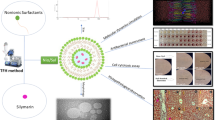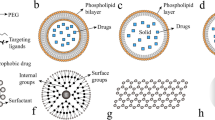Abstract
Purpose
Theranostic nanoplatforms are promising approaches for diagnosis and treatment. Here, we report a drug-loaded nanomicelle system with biocleavable gadolinium (Gd) chelates as a multifunctional biodegradable agent for simultaneous magnetic resonance imaging (MRI) and drug delivery.
Methods
Self-assembled nanomicelles based on stearic acid-grafted chitooligosaccharide were utilized as vehicles. Gd chelates, DTPA-Gds, were linked to the nanomicelles via redox-responsive disulfide bonds, and hydrophobic drugs were encapsulated in the micelle cores. MRI and cargo delivery were investigated in orthotopic pancreatic tumor-bearing mice.
Results
In vivo MRI demonstrated that the biodegradable agent was cleaved by endogenous thiols after intravenous injection, and the released DTPA-Gds were eliminated rapidly. At the same time, the agent resulted in a greater contrast enhancement of T1-weighted MR signal intensity at the tumor region than Magnevist®, and the tumor boundaries were clearly defined for at least 2 h. In addition, the agent possessed high drug-loading and tumor-targeting capacities. Loading content and encapsulation efficiency of docetaxel were 3.2% and 99.4%, respectively. Compared with Taxotere®, the commercially available docetaxel injection, the docetaxel-loaded agent significantly increased the drug concentration in tumor tissue in vivo.
Conclusion
The fabricated multifunctional agent may serve as a biodegradable nanoscale MRI contrast agent and as a drug delivery system for tumor diagnosis and treatment.









Similar content being viewed by others
Abbreviations
- BisPDSEA-DTPA-Gd:
-
Bis(2-pyridin-2-yldisulfanyl ethylamido)diethylenetriaminepentaacetic acid gadolinium complex
- CAs:
-
Contrast agents
- COS:
-
Chitooligosaccharide
- COSSA:
-
Stearic acid-grafted chitooligosaccharide
- COS-NAC:
-
N-acetylcysteine-grafted COS
- DTX:
-
Docetaxel
- MBA:
-
Multifunctional biodegradable agent
- MNGCs:
-
Macromolecular and nanoscale Gd complexes
- NAC:
-
N-acetylcysteine
- PDSEA•HCl:
-
2-(pyridin-2-yldisulfanyl)ethanamine hydrochloride
- SA:
-
Stearic acid
- -ss- :
-
Disulfide bonds
References
Geraldes CF, Laurent S. Classification and basic properties of contrast agents for magnetic resonance imaging. Contrast Media Mol I. 2009;4(1):1–23.
Caravan P, Ellison JJ, McMurry TJ, Lauffer RB. Gadolinium(III) chelates as MRI contrast agents: structure, dynamics, and applications. Chem Rev. 1999;99(9):2293–352.
U.S. Food and Drug Administration. Information on gadolinium-based contrast agents; 2017 January 19th. Available from https://www.fda.gov/drugs/drugsafety/postmarketdrugsafetyinformationforpatientsandproviders/ucm142882.htm.
Huang CH, Tsourkas A. Gd-based macromolecules and nanoparticles as magnetic resonance contrast agents for molecular imaging. Curr Top Med Chem. 2013;13(4):411–21.
Bumb A, Brechbiel MW, Choyke P. Macromolecular and dendrimer-based magnetic resonance contrast agents. Acta Radiol. 2010;51(7):751–67.
Mohs AM, Lu ZR. Gadolinium(III)-based blood-pool contrast agents for magnetic resonance imaging: status and clinical potential. Expert Opin Drug Deliv. 2007;4(2):149–64.
Weinmann HJ, Brasch RC, Press WR, Wesbey GE. Characteristics of gadolinium-DTPA complex: a potential NMR contrast agent. Am J Roentgenol. 1984;142(3):619–24.
Li X, Sun L, Wei X, Luo Q, Cai H, Xiao X, et al. Stimuli-responsive biodegradable and gadolinium-based poly[N-(2-hydroxypropyl) methacrylamide] copolymers: their potential as targeting and safe magnetic resonance imaging probes. J Mater Chem B. 2017;5(15):52763–74.
Guo C, Sun L, Cai H, Duan Z, Zhang S, Gong Q, et al. Gadolinium-labeled biodegradable dendron-hyaluronic acid hybrid and its subsequent application as a safe and efficient magnetic resonance imaging contrast agent. ACS Appl Mater Inter. 2017;9(28):23508–19.
Dong J, Liu M, Zhang K, Cao Y, Jiang B, Zu G, et al. Biocleavable oligolysine-grafted poly(disulfide amine)s as magnetic resonance imaging probes. Bioconjug Chem. 2016;27(1):151–8.
Gao X, Wang G, Shi T, Shao Z, Zhao P, Shi D, et al. Biodegradable gadolinium-chelated cationic poly(urethane amide) copolymers for gene transfection and magnetic resonance imaging. Mater Sci Eng C Mater Biol Appl. 2016;65:181–7.
Malamas AS, Jin E, Zhang Q, Haaga J, Lu ZR. Anti-angiogenic effects of bumetanide revealed by DCE-MRI with a biodegradable macromolecular contrast agent in a colon cancer model. Pharm Res. 2015;32(9):3029–43.
Xu R, Wang Y, Wang X, Jeong EK, Parker DL, Lu ZR. In Vivo evaluation of a PAMAM-cystamine-(Gd-DO3A) conjugate as a biodegradable macromolecular MRI contrast agent. Exp Biol Med. 2007;232(8):1081–9.
Vivero-Escoto JL, Taylor-Pashow KM, Huxford RC, Rocca JD, Okoruwa C, An H, et al. Multifunctional mesoporous silica nanospheres with cleavable Gd(III) chelates as MRI contrast agents: synthesis, characterization, target-specificity, and renal clearance. Small. 2011;7(24):3519–28.
Xu R, Kaneshiro TL, Jeong EK, Parker DL, Lu ZR. Synthesis and evaluation of nanoglobule-cystamine-(Gd-DO3A), a biodegradable nanosized magnetic resonance contrast agent for dynamic contrast-enhanced magnetic resonance urography. Int J Nanomedicine. 2010;5:707–13.
Rizzo LY, Theek B, Storm G, Kiessling F, Lammers T. Recent progress in nanomedicine: therapeutic, diagnostic and theranostic applications. Curr Opin Biotechnol. 2013;24(6):1159–66.
Pitchaimani A, Tuyen DTN, Wang H, Bossmann SH, Aryal S. Design and characterization of gadolinium infused theranostic liposomes. RSC Adv. 2016;6(43):36898–905.
Li L, Tong R, Li M, Kohane DS. Self-assembled gemcitabine-gadolinium nanoparticles for magnetic resonance imaging and cancer therapy. Acta Biomater. 2016;33:34–9.
Li Y, Duong HTT, Laurent S, MacMillan A, Whan RM, Elst LV, et al. Nanoparticles based on star polymers as theranostic vectors: endosomal-triggered drug release combined with MRI sensitivity. Adv Healthc Mater. 2015;4(1):148–56.
Zhu J, Xiong Z, Shen M, Shi X. Encapsulation of doxorubicin within multifunctional gadolinium-loaded dendrimer nanocomplexes for targeted theranostics of cancer cells. RSC Adv. 2015;5(38):30286–96.
Cao M, Wang P, Kou Y, Wang J, Liu J, Li Y, et al. Gadolinium(III)-chelated silica nanospheres integrating chemotherapy and photothermal therapy for cancer treatment and magnetic resonance imaging. ACS Appl Mater Inter. 2015;7(45):25014–23.
Shalviri A, Foltz WD, Cai P, Rauth AM, Wu XY. Multifunctional terpolymeric MRI contrast agent with superior signal enhancement in blood and tumor. J Control Release. 2013;167(1):11–20.
Hu FQ, Ren GF, Yuan H, Du YZ, Zeng S. Shell cross-linked stearic acid grafted chitosan oligosaccharide self-aggregated micelles for controlled release of paclitaxel. Colloids Surf B Biointerfaces. 2006;50(2):97–103.
Du YZ, Lu P, Zhou JP, Yuan H, Hu FQ. Stearic acid grafted chitosan oligosaccharide micelle as a promising vector for gene delivery system: factors affecting the complexation. Int J Pharm. 2010;391(1–2):260–6.
Schmitz T, Grabovac V, Palmberger TF, Hoffer MH, Bernkop-Schnürch A. Synthesis and characterization of a chitosan-N-acetyl cysteine conjugate. Int J Pharm. 2008;347(1–2):79–85.
Vivero-Escoto JL, Rieter WJ, Lau H, Huxford-Phillips RC, Lin W. Biodegradable polysilsesquioxane nanoparticles as efficient contrast agents for magnetic resonance imaging. Small. 2013;9(20):3523–31.
Lapidot Y, Rappoport S, Wolman Y. Use of esters of N-hydroxysuccinimide in the synthesis of N-acylamino acids. J Lipid Res. 1967;8(2):142–5.
Molina-Bolívar JA, Hierrezuelo JM, Carnero RC. Self-assembly, hydration, and structures in N-decanoyl-N-methylglucamide aqueous solutions: effect of salt addition and temperature. J Colloid Interface Sci. 2007;313(2):656–64.
Zhang W, Zheng S, Yao X, Du B, Weng W. Preparation of gadolinium-loaded stearic acid grafted chitooligosaccharide and application in pancreatic tumor imaging. Chin J Med Imag Technol. 2017;33:499–503.
Xu Z, Chen L, Gu W, Gao Y, Lin L, Zhang Z, et al. The performance of docetaxel-loaded solid lipid nanoparticles targeted to hepatocellular carcinoma. Biomaterials. 2009;30(2):226–32.
Lodhi G, Kim Y, Hwang J, Kim S, Jeon Y, Je J, et al. Chitooligosaccharide and its derivatives: preparation and biological applications. Biomed Res Int. 2014;2014:654913.
U.S. Food and Drug Administration. Magnevist injection label; 2012 March 19th. Available from https://www.accessdata.fda.gov/drugsatfda_docs/label/2012/019596s051lbl.pdf.
Lau SC, Cheung WY. Evolving treatment landscape for early and advanced pancreatic cancer. World J Gastrointest Oncol. 2017;9(7):281–92.
Padera TP, Stoll BR, Tooredman JB, Capen D, Di TE, Pathology JRK. cancer cells compress intratumour vessels. Nature. 2004;427(6976):695.
He B, Hu HY, Tan T, Wang H, Sun KX, Li YP, et al. IR-780-loaded polymeric micelles enhance the efficacy of photothermal therapy in treating breast cancer lymphatic metastasis in mice. Acta Pharmacol Sin. 2017;39:132–9.
Kuang Y, Zhang K, Cao Y, Chen X, Wang K, Liu M, et al. HydrophobicIR-780 dye encapsulated in cRGD-conjugated solid lipid nanoparticles for NIR imaging-guided photothermal therapy. ACS Appl Mater Inter. 2017;9(14):12217–26.
Meng F, Wang J, Ping Q, Yeo Y. Quantitative assessment of nanoparticle biodistribution by fluorescence imaging, revisited. ACS Nano. 2018;12(7):6458–68.
Peer D, Karp JM, Hong S, Farokhzad OC, Margalit R, Langer R. Nanocarriers as an emerging platform for cancer therapy. Nat Nanotechnol. 2007;2(12):751–60.
Acknowledgments and Disclosures
TThis work was supported by the Shanghai Natural Science Foundation (16ZR1405900). The authors thank the staff of the Center of Analysis & Test at East China University of Science and Technology for helping with the ICP-OES measurement.
Author information
Authors and Affiliations
Corresponding author
Additional information
Chuhua Xin and Xiuzhong Yao contributed equally to this work.
Rights and permissions
About this article
Cite this article
Xin, C., Yao, X., Du, B. et al. Stearic Acid-Grafted Chitooligosaccharide Nanomicelle System with Biocleavable Gadolinium Chelates as a Multifunctional Agent for Tumor Imaging and Drug Delivery. Pharm Res 36, 10 (2019). https://doi.org/10.1007/s11095-018-2530-2
Received:
Accepted:
Published:
DOI: https://doi.org/10.1007/s11095-018-2530-2




